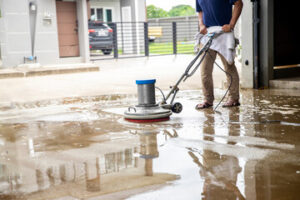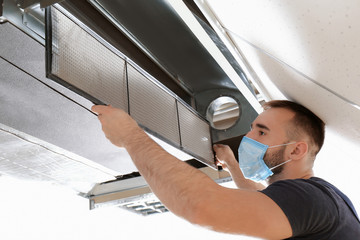Concrete surfaces are among the most durable and widely used materials in construction, but they are not immune to the accumulation of dirt, grime, oil, and stains over time. Keeping these surfaces clean is essential not only for maintaining their aesthetic appeal but also for preserving their structural integrity. Concrete Cleaner is designed to address this need, providing an effective solution for removing contaminants and restoring the surface to its original condition.
The effectiveness of a concrete cleaner lies in its formulation, which targets specific types of stains and buildup. For instance, oil and grease stains are common on driveways and garage floors, and they require cleaners with degreasing agents that can break down and lift the oily residue. On the other hand, organic stains caused by mold, mildew, or algae need cleaners with fungicidal or biocidal properties. The versatility of concrete cleaners makes them indispensable in residential, commercial, and industrial settings.
One of the critical aspects of using a concrete cleaner is understanding the nature of the stain and the condition of the surface. Concrete is porous, meaning it can absorb liquids and hold onto stains deeply. This characteristic necessitates a cleaner that can penetrate the pores of the concrete to dissolve and lift the embedded contaminants. Cleaners with surfactants are particularly effective as they reduce the surface tension of water, allowing the cleaning solution to penetrate deeper into the concrete’s pores.
Another consideration is the environmental impact of the cleaning agents. Many modern concrete cleaners are designed to be eco-friendly, utilizing biodegradable ingredients that minimize harm to the surrounding environment. This approach ensures that the cleaning process does not contribute to pollution or damage nearby vegetation. Some products also incorporate non-toxic and pH-balanced formulations, making them safer for users and reducing the risk of chemical burns or respiratory irritation during application.
The application process for concrete cleaners can vary depending on the product and the severity of the stains. For light cleaning, a diluted solution applied with a mop or sponge may suffice. However, for heavily stained or large areas, more robust methods such as pressure washing or scrubbing with a stiff-bristle brush are often necessary. In such cases, the cleaner is typically allowed to sit on the surface for a designated period to loosen the stains before being rinsed off thoroughly with water.
It is also essential to prepare the concrete surface before applying the cleaner. Sweeping or vacuuming loose debris ensures that the cleaning solution comes into direct contact with the stain without interference from dirt or dust. Additionally, pre-wetting the concrete can help prevent the cleaner from being absorbed too quickly, allowing it more time to act on the stains.
While chemical cleaners are highly effective, some users prefer natural alternatives for cleaning concrete. Ingredients like baking soda, vinegar, or hydrogen peroxide can be used to tackle minor stains and discoloration. These household items offer a cost-effective and environmentally friendly solution for basic cleaning tasks, though they may not be as effective as commercial cleaners for more stubborn stains.
In addition to removing stains, regular cleaning of concrete surfaces helps prevent the buildup of harmful substances that can degrade the material over time. For instance, deicing salts used during winter can penetrate concrete and lead to spalling or cracking when the water within the pores freezes and expands. Cleaning the surface to remove these salts can extend the lifespan of the concrete and reduce maintenance costs in the long run.
Concrete cleaners are not limited to outdoor applications. They are equally useful for indoor spaces such as basements, warehouses, and industrial facilities. In these environments, concrete floors are often subjected to heavy foot traffic, spills, and the accumulation of dust and grime. Regular cleaning ensures a safer and more hygienic space while also enhancing the appearance of the area.
Another significant application of concrete cleaners is in preparing surfaces for treatments such as sealing or painting. Proper cleaning is a crucial step in ensuring that sealants or coatings adhere effectively to the concrete. Residual dirt, grease, or other contaminants can compromise the bonding process, leading to peeling or flaking over time. By thoroughly cleaning the surface beforehand, users can achieve a more durable and visually appealing finish.
Advancements in technology have also led to the development of specialized concrete cleaners for unique applications. For example, some cleaners are formulated to remove rust stains caused by metal objects or tools left on the surface. Others are designed to eliminate efflorescence, a white powdery deposit that forms when water-soluble salts migrate to the surface of the concrete and crystallize. These specialized products cater to specific cleaning challenges, providing tailored solutions that enhance the overall effectiveness of the cleaning process.
Safety is a critical consideration when using concrete cleaners, especially those containing strong chemicals. Protective gear such as gloves, goggles, and masks should be worn to prevent skin or eye irritation and to avoid inhaling fumes. It is also important to follow the manufacturer’s instructions regarding dilution ratios, application methods, and contact time to ensure optimal results while minimizing risks. Proper ventilation during indoor use further reduces the potential for adverse effects from chemical exposure.
In addition to choosing the right cleaner, regular maintenance practices can help keep concrete surfaces looking their best. Sweeping and washing the surface periodically prevents dirt and debris from settling into the pores and becoming difficult to remove. Promptly addressing spills and stains also minimizes the risk of permanent discoloration. For outdoor areas, measures such as using mats or drip trays under vehicles can reduce the accumulation of oil and grease on the concrete.
The use of concrete cleaners extends beyond individual projects to broader applications in infrastructure and urban development. Highways, bridges, parking lots, and sidewalks are just a few examples of large-scale concrete surfaces that require cleaning to maintain safety and functionality. In these cases, the cleaning process often involves specialized equipment and techniques, as well as cleaners designed to address specific environmental or structural challenges.
Despite their effectiveness, concrete cleaners are not a one-size-fits-all solution. Choosing the right product involves evaluating factors such as the type of stain, the condition of the surface, and the desired outcome. For example, acidic cleaners are effective for removing mineral deposits and rust stains, but they can also etch or damage the surface if not used carefully. Conversely, alkaline cleaners are better suited for tackling grease and oil stains, as they neutralize acidic residues and emulsify oily substances.
Another factor to consider is the compatibility of the cleaner with other treatments applied to the concrete. For instance, sealed or polished concrete may require specific cleaners that do not degrade the protective coating or alter the surface’s appearance. Consulting the manufacturer’s recommendations or seeking professional advice can help ensure the appropriate choice of cleaner for a given application.
In recent years, the emphasis on sustainability has influenced the development of eco-friendly concrete cleaning products. These cleaners are formulated to minimize environmental impact without compromising performance. They often incorporate natural enzymes or plant-based ingredients that break down stains effectively while being biodegradable and safe for aquatic ecosystems. This shift toward greener solutions reflects a growing awareness of the importance of environmentally responsible practices in construction and maintenance.
Concrete cleaners play a vital role in maintaining the longevity and appearance of concrete surfaces. By addressing stains, dirt, and contaminants effectively, they enhance the overall functionality and aesthetics of the material. Whether for residential use, industrial maintenance, or large-scale infrastructure projects, these cleaners provide a practical and efficient solution for preserving one of the most essential building materials in modern construction.

